Rapid Identification of Aphid Species by Headspace GC-MS and Discriminant Analysis
Abstract
Simple Summary
Abstract
1. Introduction
2. Materials and Methods
3. Results and Discussion
3.1. Aphid Identification by Phylogenetic Analysis
3.2. Chemotaxonomic Approach to Differentiate Aphid Species
3.3. The Aphid Alarm Pheromone (E)-β-Farnesene (EβF) as Selection Criterion (CAP A1)
3.4. Hydrocarbon Profiles as Biomarkers for Aphid Species Differentiation (CAP A2–5)
3.5. Isothiocyanates Characterise Aphid Species Feeding on Brassicaceae (CAP A2)
3.6. Terpene Profiles of Aphid Species Feeding on Taif Rose (CAP A3/A5)
3.7. Identification of Host Plants of Aphid from Aphid Headspace Profile (CAP B1–B3)
3.8. Generation of the Dichotomous Key from CAP Analysis
3.9. Potential Production of Alkanes by Aphid Species in Taif Governorate (Saudi Arabia)
3.10. Rapid Diagnosis of Aphid Species by GC-MS and CAP Analysis
4. Conclusions and Future Perspectives
Supplementary Materials
Author Contributions
Funding
Data Availability Statement
| SUB9563655 | Aphis-craccivora-KSA-Taif | MZ091375 |
| SUB9563655 | Aphis-gossypii-KSA-Taif | MZ091376 |
| SUB9563655 | Aphis-illinoisensis-KSA-Taif | MZ091377 |
| SUB9563655 | Aphis-nerii-KSA-Taif | MZ091378 |
| SUB9563655 | Aphis-punicae-KSA-Taif | MZ091379 |
| SUB9563655 | Lipaphis-pseudobrassicae-KSA-Taif | MZ091380 |
| SUB9563655 | Rhodobium-porosum-KSA-Taif | MZ091382 |
| SUB10792914 | Eriosoma-lanigerum-KSA-Taif | OL823181 |
| SUB10792914 | Hysteroneura-setariae-KSA-Taif | OL823182 |
| SUB10792914 | Macrosiphum-rosae-KSA-taif | OL823183 |
Acknowledgments
Conflicts of Interest
References
- Blackman, R.; Eastop, V.F. Aphids on The World’s Trees—An Identification and Information Guide. Eur. J. Entomol. 2000, 94, 56. [Google Scholar]
- Guerrieri, E.; Digilio, M.C. Aphid-plant interactions: A review. J. Plant Interact. 2008, 3, 223–232. [Google Scholar] [CrossRef]
- Pickett, J.; Allemann, R.; Birkett, M. The semiochemistry of aphids. Nat. Prod. Rep. 2013, 30, 1277–1283. [Google Scholar] [CrossRef]
- Capinera, J.L. North American vegetable pests: The pattern of invasion. Am. Entomol. 2002, 48, 20–39. [Google Scholar] [CrossRef]
- Martin, J.H.; Brown, P.A. Aphids on the World’s Herbaceous Plants and Shrubs. Volume 1 Host Lists and Keys; Volume 2 the Aphids; John Wiley & Sons: Hoboken, NJ, USA, 2008; Volume 33, pp. 214–215. [Google Scholar]
- Li, Z.; Lyu, Z.; Ye, Q.; Cheng, J.; Wang, C.; Lin, T. Cloning, Expression Analysis, 20-Hydroxyecdysone Induction, and RNA Interference Study of Autophagy-Related Gene 8 from Heortia vitessoides Moore. Insects 2020, 11, 245. [Google Scholar] [CrossRef] [PubMed]
- Peccoud, J.; Simon, J.-C.; von Dohlen, C.; Coeur d’acier, A.; Plantegenest, M.; Vanlerberghe-Masutti, F.; Jousselin, E. Evolutionary history of aphid-plant association and their role in aphid diversification. Comptes Rendus Biol. 2010, 333, 474–487. [Google Scholar] [CrossRef] [PubMed]
- Hartbauer, M. Collective Defense of Aphis nerii and Uroleucon hypochoeridis (Homoptera, Aphididae) against Natural Enemies. PLoS ONE 2010, 5, e10417. [Google Scholar] [CrossRef]
- Borowiak-Sobkowiak, B.; Durak, R.; Wilkaniec, B. Morphology, biology and behavioral aspects of aphis craccivora (Hemiptera: Aphididae) on robinia pseudoacacia. Acta Sci. Pol. Hortorum Cultus 2017, 16, 39–49. [Google Scholar]
- Tálaga-Taquinas, W.; Melo Cerón, C.; Lagos, Y.; Duque-Gamboa, D.; Toro-Perea, N.; Manzano, M. Identification and life history of aphids associated with chili pepper crops in southwestern Colombia. Univ. Sci. 2020, 25, 175–200. [Google Scholar] [CrossRef]
- Blackman, R.; Eastop, V.F. Aphids on the World’s Herbaceous Plants and Shrubs. Eur. J. Entomol. 2008, 105, 164. [Google Scholar] [CrossRef]
- Alsufyani, T.; Al-Otaibi, N.; Alotaibi, N.J.; M’sakni, N.H.; Alghamdi, E.M. GC Analysis, Anticancer, and Antibacterial Activities of Secondary Bioactive Compounds from Endosymbiotic Bacteria of Pomegranate Aphid and Its Predator and Protector. Molecules 2023, 28, 4255. [Google Scholar] [CrossRef] [PubMed]
- Hatano, E.; Kunert, G.; Michaud, J.P.; Weisser, W. Chemical cues mediating aphid location by natural enemies. Eur. J. Entomol. 2008, 105, 797–806. [Google Scholar] [CrossRef]
- Xiu, C.; Zhang, W.; Xu, B.; Wyckhuys, K.; Cai, X.; Su, H.; Lu, Y. Volatiles from aphid-infested plants attract adults of the multicolored Asian lady beetle Harmonia axyridis. Biol. Control 2018, 129, 1–11. [Google Scholar] [CrossRef]
- Cusumano, A.; Harvey, J.A.; Bourne, M.E.; Poelman, E.H.; de Boer, J.G. Exploiting chemical ecology to manage hyperparasitoids in biological control of arthropod pests. Pest Manag. Sci. 2020, 76, 432–443. [Google Scholar] [CrossRef] [PubMed]
- Tinzaara, W.; Dicke, M.; Huis, A.; Gold, C.s. Use of infochemicals in Pest Management with Special Reference to the Banana Weevil, Cosmopolites sordidus (Germar) (Coleoptera: Curculionidae). Insect Sci. Its Appl. 2002, 22, 241–261. [Google Scholar] [CrossRef]
- Goggin, L. Plant-aphid interactions: Molecular and ecological perspectives. Curr. Opin. Plant Biol. 2007, 10, 399–408. [Google Scholar] [CrossRef]
- Liu, J.; Zhao, X.; Zhan, Y.; Wang, K.; Francis, F.; Liu, Y. New slow release mixture of (E)-β-farnesene with methyl salicylate to enhance aphid biocontrol efficacy in wheat ecosystem. Pest Manag. Sci. 2021, 77, 3341–3348. [Google Scholar] [CrossRef]
- Kumar, S. Aphid-Plant Interactions: Implications for Pest Management; IntechOpen: London, UK, 2019. [Google Scholar] [CrossRef]
- Favret, C.; Eades, D. Introduction to Aphid Species File, https://Aphid.SpeciesFile.org. Redia 2009, 92, 115–117. [Google Scholar]
- Favret, C. Cybertaxonomy to accomplish big things in aphid systematics. Insect Sci. 2014, 21, 392–399. [Google Scholar] [CrossRef]
- Suganthi, M.; Abirami, G.; Jayanthi, M.; Kumar, K.A.; Karuppanan, K.; Palanisamy, S. A method for DNA extraction and molecular identification of Aphids. MethodsX 2023, 10, 102100. [Google Scholar] [CrossRef]
- Perera, M.R.; Vargas, R.D.F.; Jones, M.G.K. Identification of aphid species using protein profiling and matrix-assisted laser desorption/ionization time-of-flight mass spectrometry. Entomol. Exp. Appl. 2005, 117, 243–247. [Google Scholar] [CrossRef]
- Thorpe, P.; Cock, P.J.A.; Bos, J. Comparative transcriptomics and proteomics of three different aphid species identifies core and diverse effector sets. BMC Genom. 2016, 17, 172. [Google Scholar] [CrossRef] [PubMed]
- Chen, N.; Bai, Y.; Fan, Y.-L.; Liu, T.-X. Solid-phase microextraction-based cuticular hydrocarbon profiling for intraspecific delimitation in Acyrthosiphon pisum. PLoS ONE 2017, 12, e0184243. [Google Scholar] [CrossRef] [PubMed]
- Durak, R.; Ciak, B.; Durak, T. Highly Efficient Use of Infrared Spectroscopy (ATR-FTIR) to Identify Aphid Species. Biology 2022, 11, 1232. [Google Scholar] [CrossRef]
- Qin, M.; Chen, J.; Jiang, L.; Qiao, G. Insights into the Species-Specific Microbiota of Greenideinae (Hemiptera: Aphididae) with Evidence of Phylosymbiosis. Front. Microbiol. 2022, 13, 828170. [Google Scholar] [CrossRef]
- Sreenivasulu, B.; Paramageetham, C.; Sreenivasulu, D.; Suman, B.; Umamahesh, K.; Babu, G.P. Analysis of Chemical Signatures of Alkaliphiles using Fatty Acid Methyl Ester Analysis. J. Pharm. Bioallied Sci. 2017, 9, 106–114. [Google Scholar] [CrossRef]
- Quezada, M.; Buitrón, G.; Moreno-Andrade, I.; Moreno, G.; López-Marín, L.M. The use of fatty acid methyl esters as biomarkers to determine aerobic, facultatively aerobic and anaerobic communities in wastewater treatment systems. FEMS Microbiol. Lett. 2007, 266, 75–82. [Google Scholar] [CrossRef]
- Heyrman, J.; Mergaert, J.; Denys, R.; Swings, J. The use of fatty acid methyl ester analysis (FAME) for the identification of heterotrophic bacteria present on three mural paintings showing severe damage by microorganisms. FEMS Microbiol. Lett. 1999, 181, 55–62. [Google Scholar] [CrossRef]
- Ford, P.W.; Berger, T.A.; Jackoway, G. Spice authentication by fully automated chemical analysis with integrated chemometrics. J. Chromatogr. A 2022, 1667, 462889. [Google Scholar] [CrossRef]
- Álvarez-Buylla, A.; Culebras, E.; Picazo, J.J. Identification of Acinetobacter species: Is Bruker biotyper MALDI-TOF mass spectrometry a good alternative to molecular techniques? Infect. Genet. Evol. 2012, 12, 345–349. [Google Scholar] [CrossRef]
- El-Sayed, A.M. The Pherobase: Database of Pheromones and Semiochemicals. 2023. Available online: https://www.pherobase.com/ (accessed on 26 May 2023).
- Lemfack, M.C.; Gohlke, B.O.; Toguem, S.M.T.; Preissner, S.; Piechulla, B.; Preissner, R. Microbial volatile organic compound database. Nucleic Acids Res. 2017. Available online: https://bioinformatics.charite.de/mvoc/ (accessed on 15 June 2020).
- Preissner, R. Global Natural Products Social Molecular Networking (GNPS). 2022. Available online: https://gnps.ucsd.edu/ProteoSAFe/static/gnps-splash.jsp/ (accessed on 20 May 2022).
- Schulz, S.; Möllerke, A. Mass Spectra for Chemical Ecology (MACE); Technische Universität Braunschweig: Braunschweig, Germany, 2023. [Google Scholar]
- James Rohlf, F.; Marcus, L.F. A revolution morphometrics. Trends Ecol. Evol. 1993, 8, 129–132. [Google Scholar] [CrossRef] [PubMed]
- Mutanen, M. Delimitation difficulties in species splits: A morphometric case study on the Euxoa tritici complex (Lepidoptera, Noctuidae). Syst. Entomol. 2005, 30, 632–643. [Google Scholar] [CrossRef]
- Iwata, H.; Ukai, Y. SHAPE: A Computer Program Package for Quantitative Evaluation of Biological Shapes Based on Elliptic Fourier Descriptors. J. Hered. 2002, 93, 384–385. [Google Scholar] [CrossRef] [PubMed]
- Francoy, T.M.; Wittmann, D.; Drauschke, M.; Müller, S.; Steinhage, V.; Bezerra-Laure, M.A.F.; De Jong, D.; Gonçalves, L.S. Identification of Africanized honey bees through wing morphometrics: Two fast and efficient procedures. Apidologie 2008, 39, 488–494. [Google Scholar] [CrossRef]
- Weeks, P.J.D.; O’Neill, M.A.; Gaston, K.J.; Gauld, I.D. Species–identification of wasps using principal component associative memories. Image Vis. Comput. 1999, 17, 861–866. [Google Scholar] [CrossRef]
- McGuire, M.J.; Krasner, S.W.; Hwang, C.J.; Izaguirre, G. Closed-loop stripping analysis as a tool for solving taste and odor problems. J.-Am. Water Work. Assoc. 1981, 73, 530–537. [Google Scholar] [CrossRef]
- Graydon, J.W.; Grob, K.; Zuercher, F.; Giger, W. Determination of highly volatile organic contaminants in water by the closed-loop gaseous stripping technique followed by thermal desorption of the activated carbon filters. J. Chromatogr. A 1984, 285, 307–318. [Google Scholar] [CrossRef]
- Anderson, M.J.; Willis, T.J. Canonical analysis of principal coordinates: A useful method of constrained ordination for ecology. Ecology 2003, 84, 511–525. [Google Scholar] [CrossRef]
- Folmer, O.; Black, M.; Wr, H.; Lutz, R.; Vrijenhoek, R. DNA primers for amplification of mitochondrial Cytochrome C oxidase subunit I from diverse metazoan invertebrates. Mol. Mar. Biol. Biotechnol. 1994, 3, 294–299. [Google Scholar]
- Sabir, J.; Rabah, S.; Yacoub, H.; Hajrah, N.; Atef, A.; Almatry, M.; Edris, S.; Alharbi, M.; Ganash, M.; Mahyoub, J.; et al. Molecular evolution of cytochrome C oxidase-I protein of insects living in Saudi Arabia. PLoS ONE 2019, 14, e0224336. [Google Scholar] [CrossRef]
- Krzanowski, W.J. Principles of Multivariate Analysis: A User’s Perspective; Oxford University Press: Oxford, UK, 2003. [Google Scholar]
- Francis, F.; Lognay, G.; Haubruge, E. Olfactory Responses to Aphid and Host Plant Volatile Releases: (E)-β-Farnesene an Effective Kairomone for the Predator Adalia bipunctata. J. Chem. Ecol. 2004, 30, 741–755. [Google Scholar] [CrossRef] [PubMed]
- Barretto, D.; Kumar, S. GC-MS Analysis of Bioactive Compounds and Antimicrobial Activity of Cryptococcus rajasthanensis KY627764 Isolated from Bombyx mori Gut Microflora. Int. J. Adv. Res. 2018, 6, 525–538. [Google Scholar] [CrossRef] [PubMed]
- Sengun, I.; Gargı, A. Comparative Study of Total Phenolic Contents, Antioxidant and Antimicrobial Activities of Different Extracts of Corchorus olitorius L. Growing in North Cyprus. Biodivers. Conserv. 2020, 13, 298–304. [Google Scholar] [CrossRef]
- Han, B.Y.; Chen, Z.M. Composition of the Volatiles from Intact and Mechanically Pierced Tea Aphid−Tea Shoot Complexes and Their Attraction to Natural Enemies of the Tea Aphid. J. Agric. Food Chem. 2002, 50, 2571–2575. [Google Scholar] [CrossRef]
- El-Kareim, A.; Ramadan, M.M.; Nada, G.A. Kairomone and Synomone Mediating Cowpea Aphid, Aphis Craccivora Location by some Natural Enemies. J. Plant Prot. Pathol. 2021, 12, 775–781. [Google Scholar] [CrossRef]
- Szafranek, B.; Maliñski, E.; Nawrot, J.; Sosnowska, D.; Ruszkowska, M.; Pihlaja, K.; Trumpakaj, Z.; Szafranek, J. In Vitro effects of cuticular lipids of the aphids Sitobion avenae, Hyalopterus pruni and Brevicoryne brassicae on growth and sporulation of the Paecilomyces fumosoroseus and Beauveria bassiana. ARKIVOC Arch. Org. Chem. 2001, 2, 81–94. [Google Scholar] [CrossRef]
- Shonouda, M.L.; Bombosch, S.; Shalaby, A.M.; Osman, S.I. Biological and chemical characterization of a kairomone excreted by the bean aphids, Aphis fabae Scop. (Hom., Aphididae) and its effect on the predator Metasyrphus corollae Fabr. I. Isolation, identification and bioassay of aphid-kairomone. J. Appl. Entomol. 1998, 122, 15–23. [Google Scholar] [CrossRef]
- Muñoz, O.; Argandoña, V.H.; Corcuerac, L.J. Chemical Constituents from Shoots of Hordeum vulgare Infested by the Aphid Schizaphis graminum. Z. Nat. C 1998, 53, 811–817. [Google Scholar] [CrossRef]
- Ahmed, Q.; Agarwal, M.; Alobaidi, R.; Zhang, H.; Ren, Y. Response of Aphid Parasitoids to Volatile Organic Compounds from Undamaged and Infested Brassica oleracea with Myzus persicae. Molecules 2022, 27, 1522. [Google Scholar] [CrossRef]
- Pokharel, S.S.; Zhong, Y.; Changning, L.; Shen, F.; Likun, L.; Parajulee, M.N.; Fang, W.; Chen, F. Influence of reduced N-fertilizer application on foliar chemicals and functional qualities of tea plants under Toxoptera aurantii infestation. BMC Plant Biol. 2022, 22, 166. [Google Scholar] [CrossRef]
- Ali, M.F.; Morgan, E.D.; Attygalle, A.B.; Billen, J.P.J. Comparison of Dufour Gland Secretions of Two Species of Leptothorax Ants (Hymenoptera: Formicidae). Z. Nat. C 1987, 42, 955–960. [Google Scholar] [CrossRef]
- Yang, Y.; Li, X.; Liu, D.; Pei, X.; Khoso, A.G. Rapid Changes in Composition and Contents of Cuticular Hydrocarbons in Sitobion avenae (Hemiptera: Aphididae) Clones Adapting to Desiccation Stress. J. Econ. Entomol. 2022, 115, 508–518. [Google Scholar] [CrossRef]
- Eisenschmidt-Bönn, D.; Schneegans, N.; Backenköhler, A.; Wittstock, U.; Brandt, W. Structural diversification during glucosinolate breakdown: Mechanisms of thiocyanate, epithionitrile and simple nitrile formation. Plant J. 2019, 99, 329–343. [Google Scholar] [CrossRef] [PubMed]
- Müller, C.; Wittstock, U. Uptake and turn-over of glucosinolates sequestered in the sawfly Athalia rosae. Insect Biochem. Mol. Biol. 2005, 35, 1189–1198. [Google Scholar] [CrossRef] [PubMed]
- Wittstock, U.; Burow, M. Glucosinolate breakdown in Arabidopsis: Mechanism, regulation and biological significance. Arab. Book/Am. Soc. Plant Biol. 2010, 8. [Google Scholar] [CrossRef]
- Fahey, J.W.; Zalcmann, A.T.; Talalay, P. The chemical diversity and distribution of glucosinolates and isothiocyanates among plants. Phytochemistry 2001, 56, 5–51. [Google Scholar] [CrossRef]
- Bridges, M.; Jones, A.M.; Bones, A.M.; Hodgson, C.; Cole, R.; Bartlet, E.; Wallsgrove, R.; Karapapa, V.K.; Watts, N.; Rossiter, J.T. Spatial organization of the glucosinolate-myrosinase system in brassica specialist aphids is similar to that of the host plant. Proc. Biol. Sci. 2002, 269, 187–191. [Google Scholar] [CrossRef]
- Kazana, E.; Pope, T.W.; Tibbles, L.; Bridges, M.; Pickett, J.A.; Bones, A.M.; Powell, G.; Rossiter, J.T. The cabbage aphid: A walking mustard oil bomb. Proc. Biol. Sci. 2007, 274, 2271–2277. [Google Scholar] [CrossRef]
- Gouinguené, S.P.; Turlings, T.C.J. The Effects of Abiotic Factors on Induced Volatile Emissions in Corn Plants. Plant Physiol. 2002, 129, 1296–1307. [Google Scholar] [CrossRef]
- Dudareva, N.; Klempien, A.; Muhlemann, J.K.; Kaplan, I. Biosynthesis, function and metabolic engineering of plant volatile organic compounds. New Phytol. 2013, 198, 16–32. [Google Scholar] [CrossRef]
- Rusanov, K.; Kovacheva, N.; Rusanova, M.; Atanassov, I. Traditional Rosa damascena flower harvesting practices evaluated through GC/MS metabolite profiling of flower volatiles. Food Chem. 2011, 129, 1851–1859. [Google Scholar] [CrossRef]
- Du, X.; Witzgall, P.; Wu, K.; Yan, F.; Ma, C.; Zheng, H.; Xu, F.; Ji, G.; Wu, X. Volatiles from Prunus persica Flowers and Their Correlation with Flower-Visiting Insect Community in Wanbailin Ecological Garden, China. Adv. Entomol. 2017, 06, 116–133. [Google Scholar] [CrossRef]
- Čandek, K.; Kuntner, M. DNA barcoding gap: Reliable species identification over morphological and geographical scales. Mol. Ecol. Resour. 2014, 15, 268–277. [Google Scholar] [CrossRef]
- Pickett, J.; Griffiths, D. Composition of aphid alarm pheromones. J. Chem. Ecol. 1980, 6, 349–360. [Google Scholar] [CrossRef]
- Francis, F.; Martin, T.; Lognay, G.; Haubruge, E. Role of (E)-beta-farnesene in systematic aphid prey location by Episyrphus balteatus larvae (Diptera: Syrphidae). Eur. J. Entomol. 2005, 102, 431–436. [Google Scholar] [CrossRef]
- Vosteen, I.; Weisser, W.; Kunert, G. Is there any evidence that aphid alarm pheromones work as prey and host finding kairomones for natural enemies? Ecol. Entomol. 2016, 41, 1–12. [Google Scholar] [CrossRef]
- Song, X.; Qin, Y.G.; Yin, Y.; Li, Z.X. Identification and Behavioral Assays of Alarm Pheromone in the Vetch Aphid Megoura viciae. J. Chem. Ecol. 2021, 47, 740–746. [Google Scholar] [CrossRef]
- Kinyanjui, G.; Khamis, F.M.; Mohamed, S.; Ombura, L.O.; Warigia, M.; Ekesi, S. Identification of aphid (Hemiptera: Aphididae) species of economic importance in Kenya using DNA barcodes and PCR-RFLP-based approach. Bull. Entomol. Res. 2016, 106, 63–72. [Google Scholar] [CrossRef]
- Raboudi, F.; Mezghani Khemakhem, M.; Makni, H.; Marrakchi, M.; Rouault, J.-D.; Makni, M. Aphid species identification using cuticular hydrocarbons and cytochrome b gene sequences. J. Appl. Entomol. 2005, 129, 75–80. [Google Scholar] [CrossRef]
- Chen, T.; Li, Q.; Guo-Jun, Q.; Gao, Y.; Zhao, C.; Lu, L.H. Cuticular hydrocarbon pattern as a chemotaxonomy marker to assess six species of thrips. J. Asia-Pac. Entomol. 2020, 23, 1255–1263. [Google Scholar] [CrossRef]
- Robert Owen, B., III. Uses of Portable Gas Chromatography Mass Spectrometers. In Novel Aspects of Gas Chromatography and Chemometrics; Serban, C.M., Vu Dang, H., Victor, D., Eds.; IntechOpen: Rijeka, Croatia, 2022; Chapter 3. [Google Scholar] [CrossRef]
- Fair, J.D.; Bailey, W.F.; Felty, R.A.; Gifford, A.E.; Shultes, B.; Volles, L.H. Quantitation by Portable Gas Chromatography: Mass Spectrometry of VOCs Associated with Vapor Intrusion. Int. J. Anal. Chem. 2010, 2010, 278078. [Google Scholar] [CrossRef]
- Yang, B.; Zhang, Z.; Yang, C.-q.; Wang, Y.; Orr, M.; Wang, H.; Zhang, A.B. Identification of Species by Combining Molecular and Morphological Data Using Convolutional Neural Networks. Syst. Biol. 2021, 71, 690–705. [Google Scholar] [CrossRef]
- Šigut, M.; Kostovčík, M.; Šigutová, H.; Hulcr, J.; Drozd, P.; Hrček, J. Performance of DNA metabarcoding, standard barcoding, and morphological approach in the identification of host-parasitoid interactions. PLoS ONE 2017, 12, e0187803. [Google Scholar] [CrossRef] [PubMed]
- Zhang, H.; Yan, H.; Li, Q.; Lin, H.; Wen, X. Identification of VOCs in essential oils extracted using ultrasound- and microwave-assisted methods from sweet cherry flower. Sci. Rep. 2021, 11, 1167. [Google Scholar] [CrossRef] [PubMed]
- Zhang, Z.; Yin, C.; Liu, Y.; Jie, W.; Lei, W.; Li, F. iPathCons and iPathDB: An improved insect pathway construction tool and the database. Database 2014, 2014, bau105. [Google Scholar] [CrossRef] [PubMed]
- Guo, K.; Yang, P.; Chen, J.; Lu, H.; Cui, F. Transcriptomic responses of three aphid species to chemical insecticide stress. Sci. China Life Sci. 2017, 60, 931–934. [Google Scholar] [CrossRef]
- Kivimäenpää, M.; Babalola, A.; Joutsensaari, J.; Holopainen, J. Methyl Salicylate and Sesquiterpene Emissions Are Indicative for Aphid Infestation on Scots Pine. Forests 2020, 11, 573. [Google Scholar] [CrossRef]
- Singewar, K.; Fladung, M.; Robischon, M. Methyl salicylate as a signaling compound that contributes to forest ecosystem stability. Trees 2021, 35, 1755–1769. [Google Scholar] [CrossRef]
- Shulaev, V.; Silverman, P.; Raskin, I. Airborne signalling by methyl salicylate in plant pathogen resistance. Nature 1997, 385, 718–721. [Google Scholar] [CrossRef]
- Ninkovic, V.; Glinwood, R.; Ünlü, A.G.; Ganji, S.; Unelius, C.R. Effects of Methyl Salicylate on Host Plant Acceptance and Feeding by the Aphid Rhopalosiphum padi. Front. Plant Sci. 2021, 12, 710268. [Google Scholar] [CrossRef]
- Fukatsu, T. Secondary intracellular symbiotic bacteria in aphids of the genus Yamatocallis (Homoptera: Aphididae: Drepanosiphinae). Appl. Environ. Microbiol. 2001, 67, 5315–5320. [Google Scholar] [CrossRef] [PubMed]
- Pons, I.; Renoz, F.; Noël, C.; Hance, T. New Insights into the Nature of Symbiotic Associations in Aphids: Infection Process, Biological Effects, and Transmission Mode of Cultivable Serratia symbiotica Bacteria. Appl. Environ. Microbiol. 2019, 85, e02445-18. [Google Scholar] [CrossRef] [PubMed]
- Whitehead, L.F.; Douglas, A.E. Populations of symbiotic bacteria in the parthenogenetic pea aphid (Acyrthosiphon pisum) symbiosis. Proc. R. Soc. Lond. Ser. B Biol. Sci. 1993, 254, 29–32. [Google Scholar] [CrossRef]
- Beekwilder, J.; Alvarez-Huerta, M.; Neef, E.; Verstappen, F.W.; Bouwmeester, H.J.; Aharoni, A. Functional characterization of enzymes forming volatile esters from strawberry and banana. Plant Physiol. 2004, 135, 1865–1878. [Google Scholar] [CrossRef] [PubMed]
- Vela, J.; Montiel, E.E.; Mora, P.; Lorite, P.; Palomeque, T. Aphids and Ants, Mutualistic Species, Share a Mariner Element with an Unusual Location on Aphid Chromosomes. Genes 2021, 12, 1966. [Google Scholar] [CrossRef] [PubMed]
- Kochansky, J.; Aldrich, J.R.; Lusby, W.R. Synthesis and pheromonal activity of 6,10,13-trimethyl-1-tetradecanol for predatory stink bug, Stiretrus anchorago (Heteroptera: Pentatomidae). J. Chem. Ecol. 1989, 15, 1717–1728. [Google Scholar] [CrossRef] [PubMed]
- Kergunteuil, A.; Dugravot, S.; Danner, H.; Dam, N.; Cortesero, A.M. Characterizing Volatiles and Attractiveness of Five Brassicaceous Plants with Potential for a ‘Push-Pull’ Strategy Toward the Cabbage Root Fly, Delia radicum. J. Chem. Ecol. 2015, 41, 330–339. [Google Scholar] [CrossRef]
- Ahmed, Q.; Agarwal, M.; Al-Obaidi, R.; Wang, P.; Ren, Y. Evaluation of Aphicidal Effect of Essential Oils and Their Synergistic Effect against Myzus persicae (Sulzer) (Hemiptera: Aphididae). Molecules 2021, 26, 3055. [Google Scholar] [CrossRef]
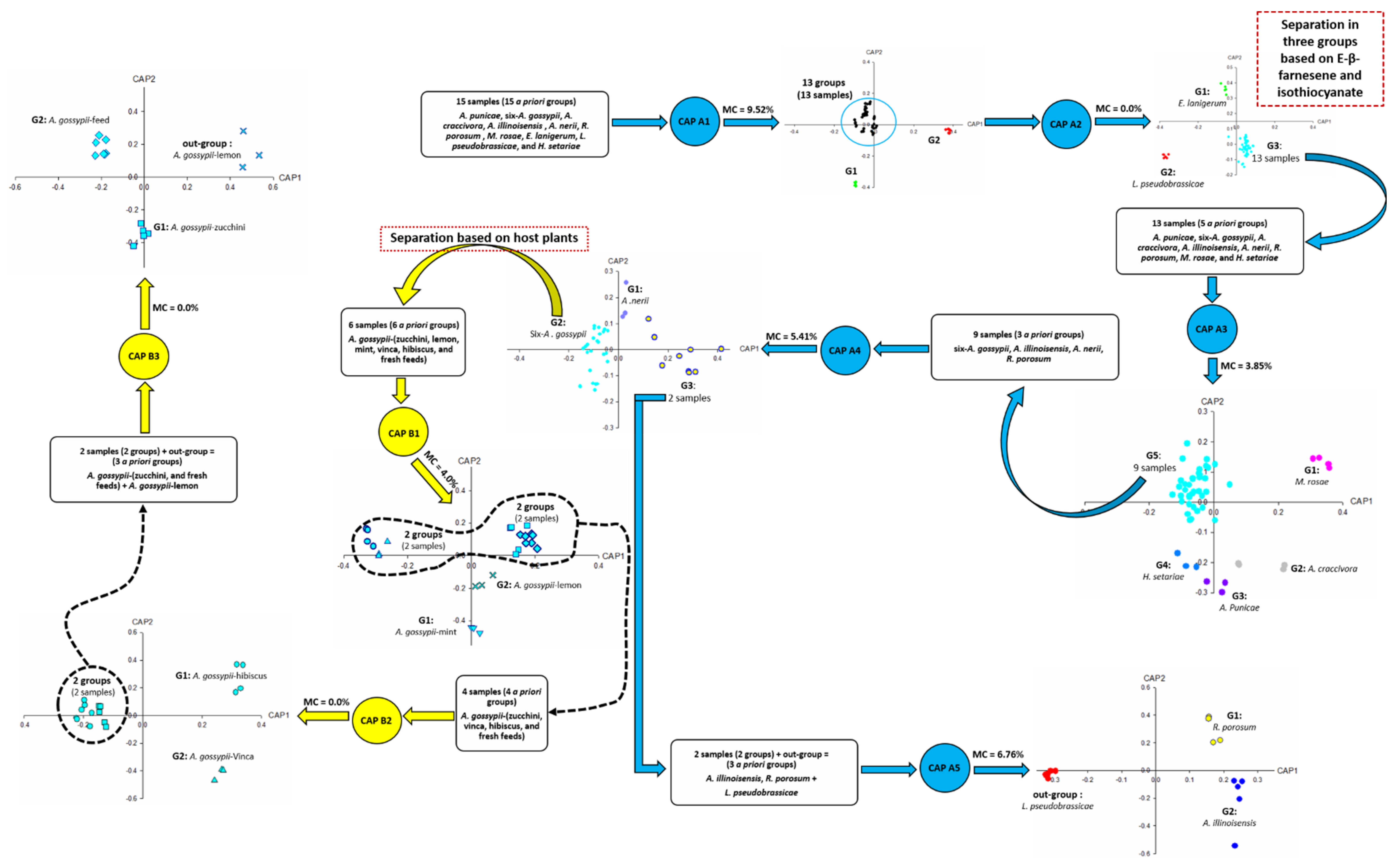
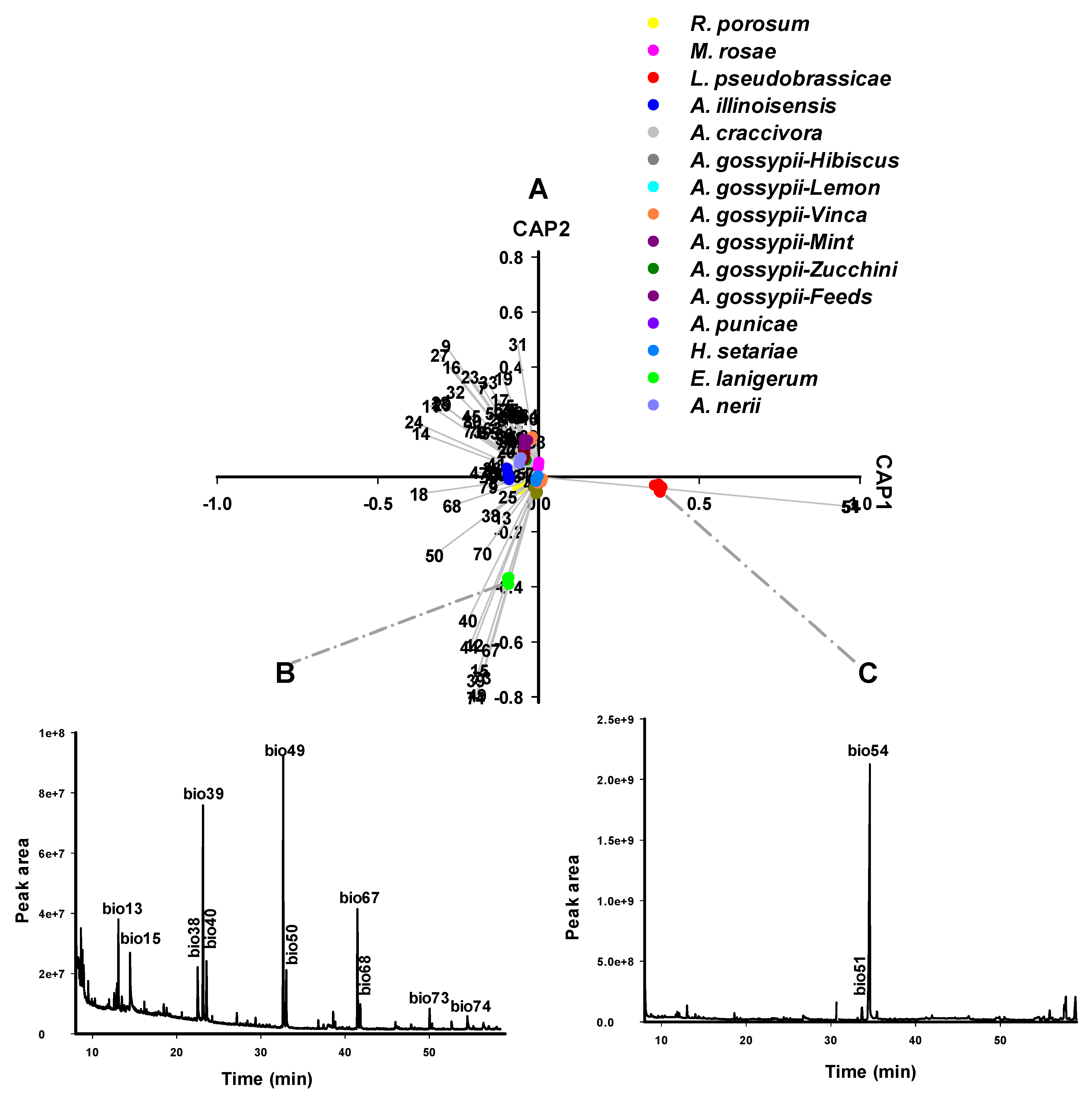
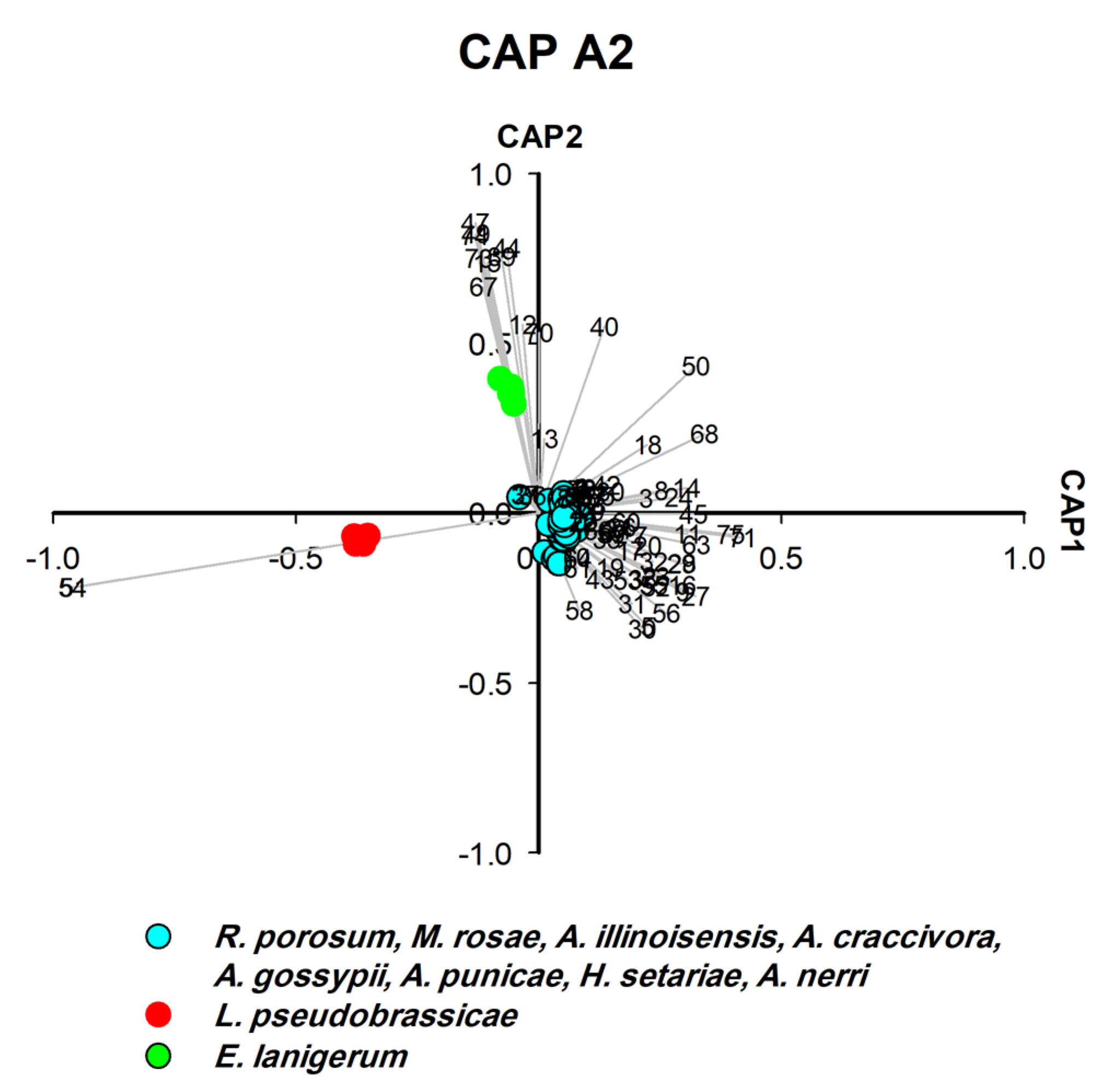

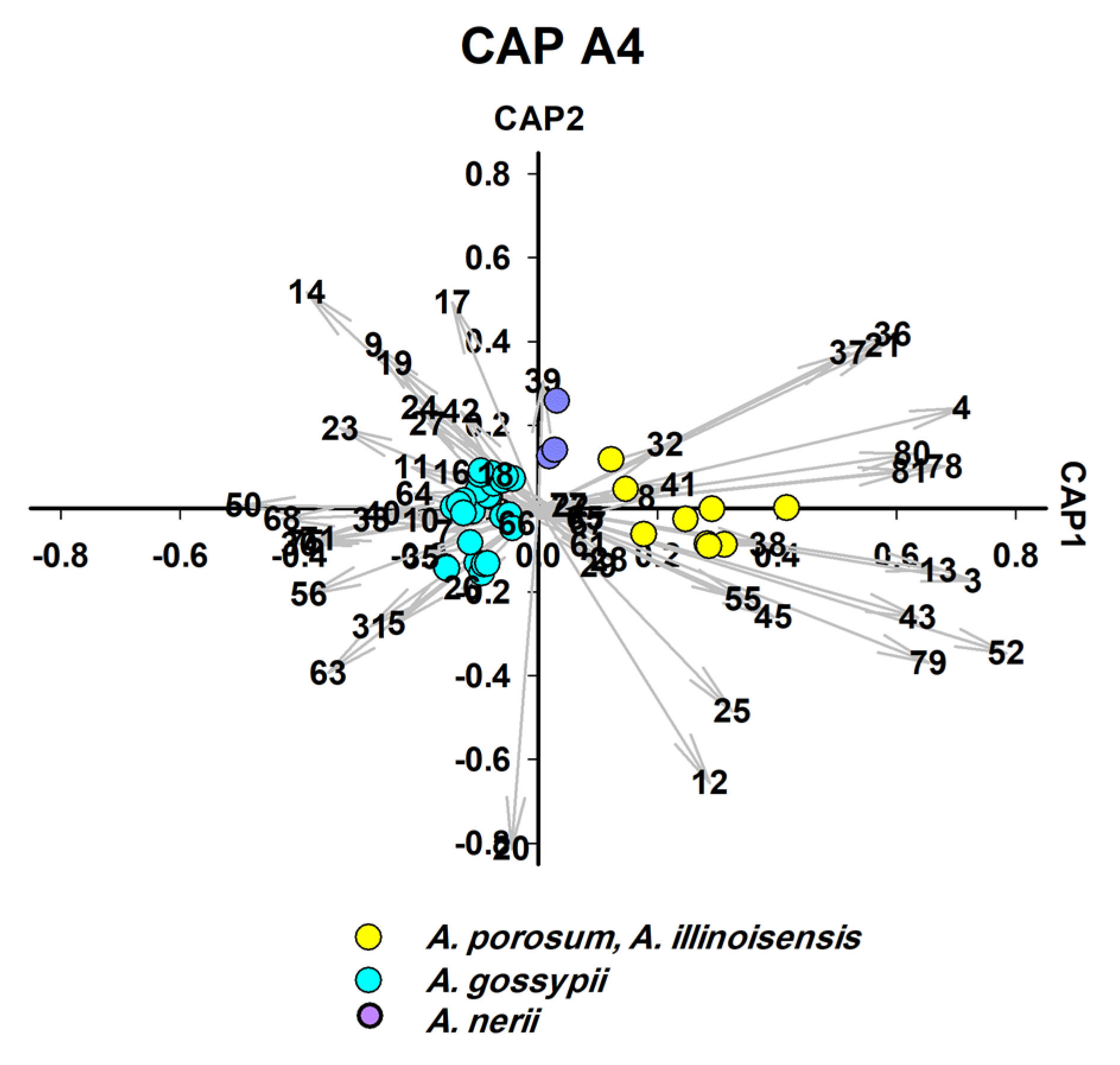
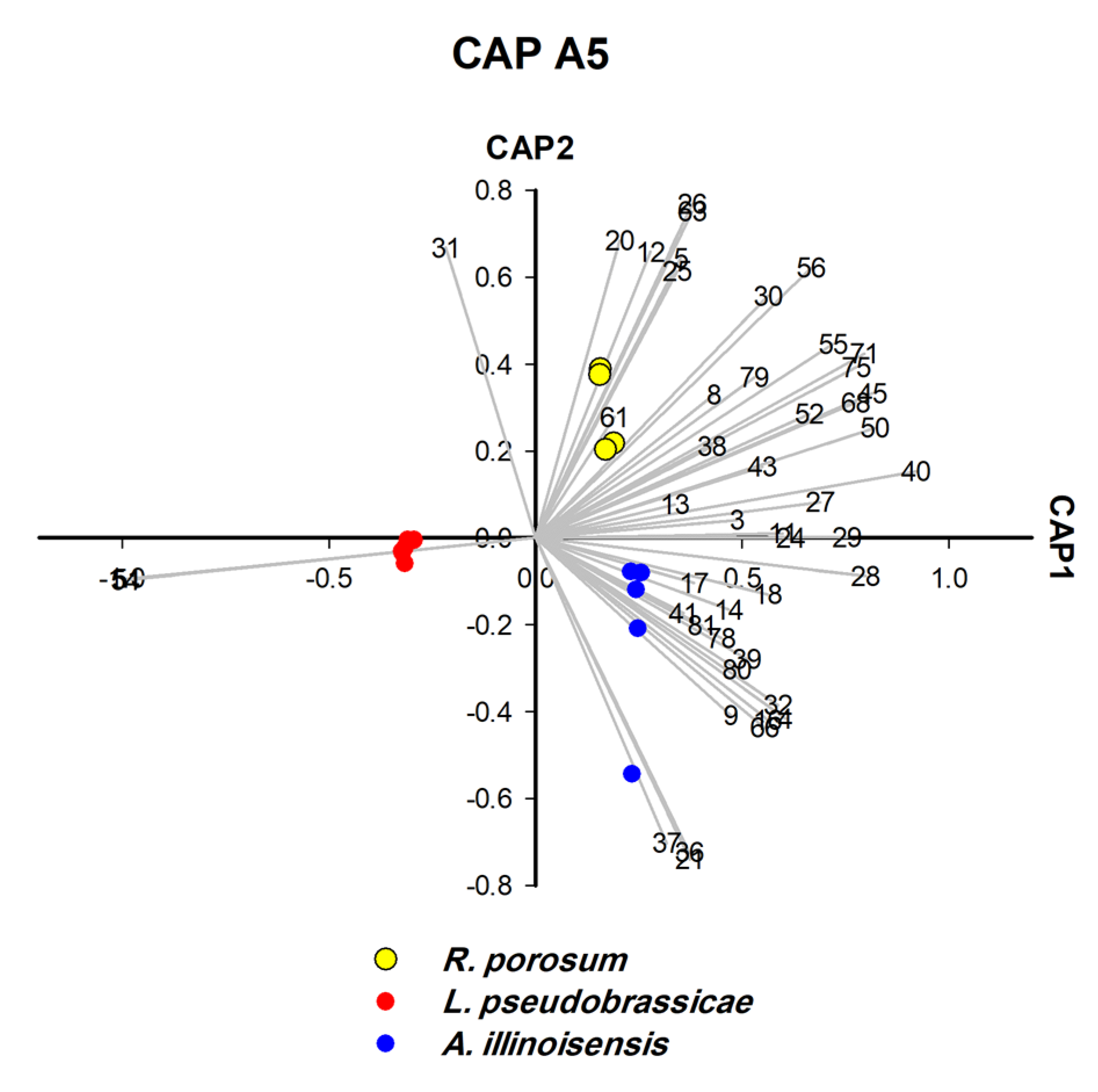
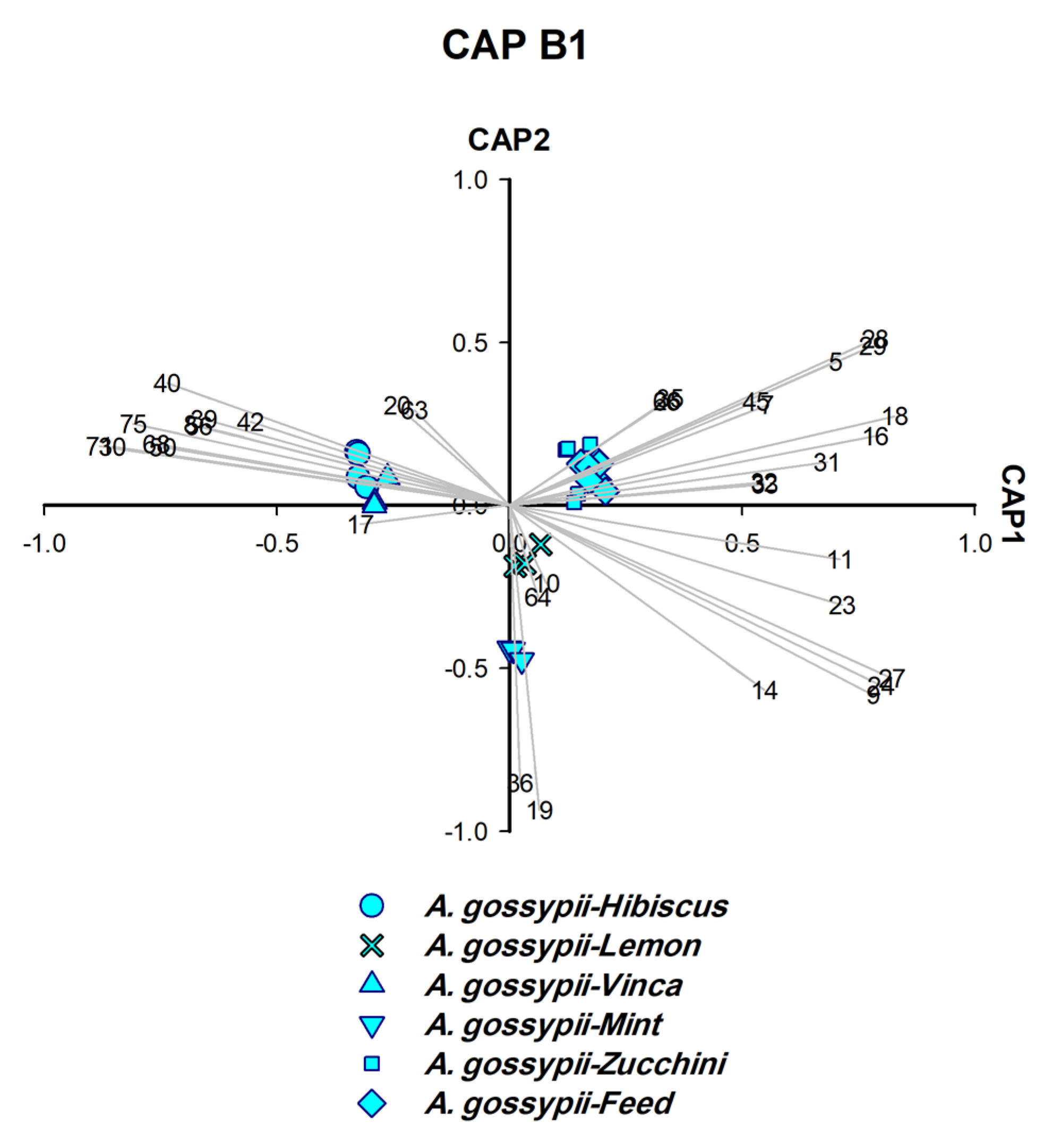
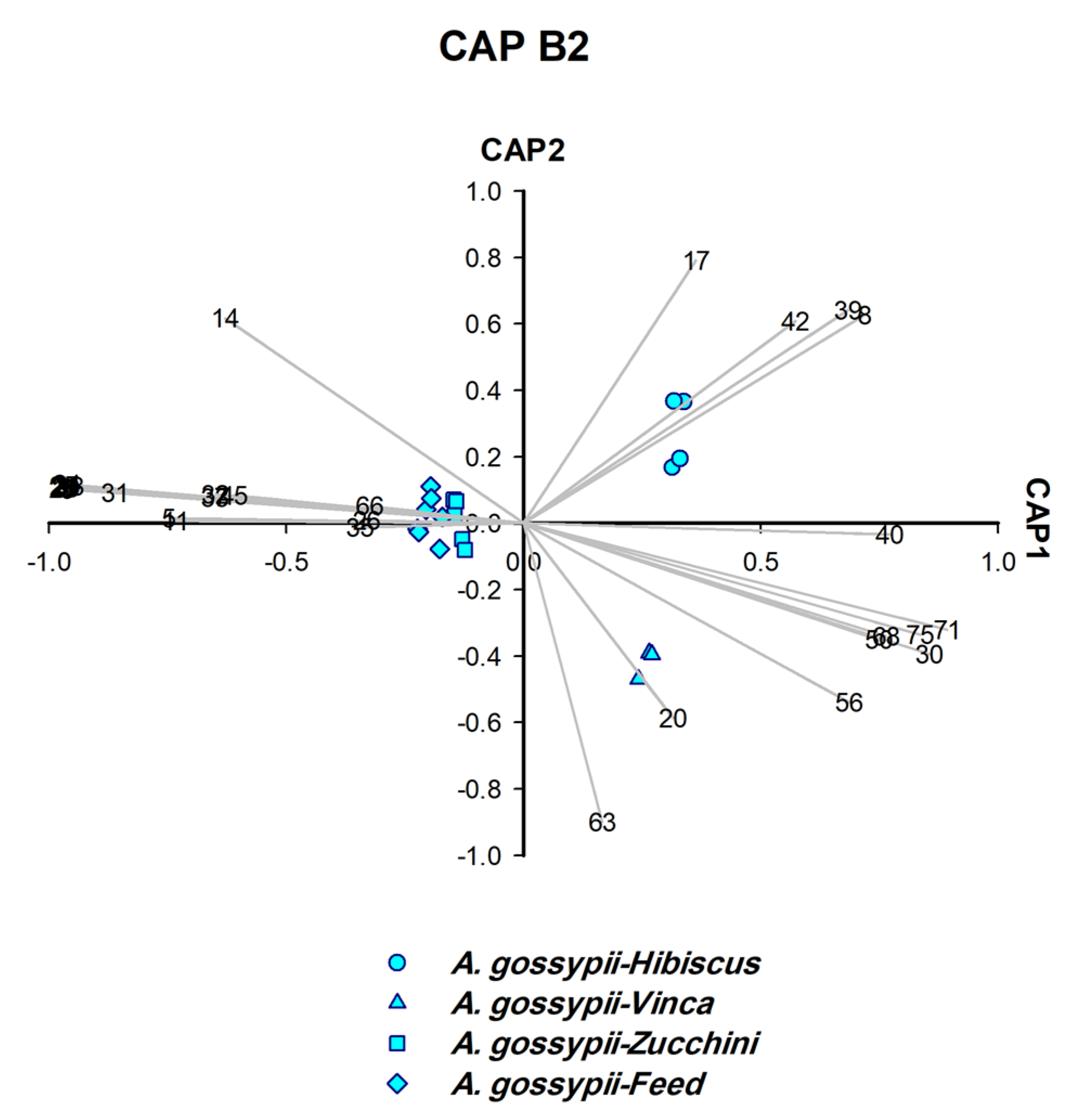

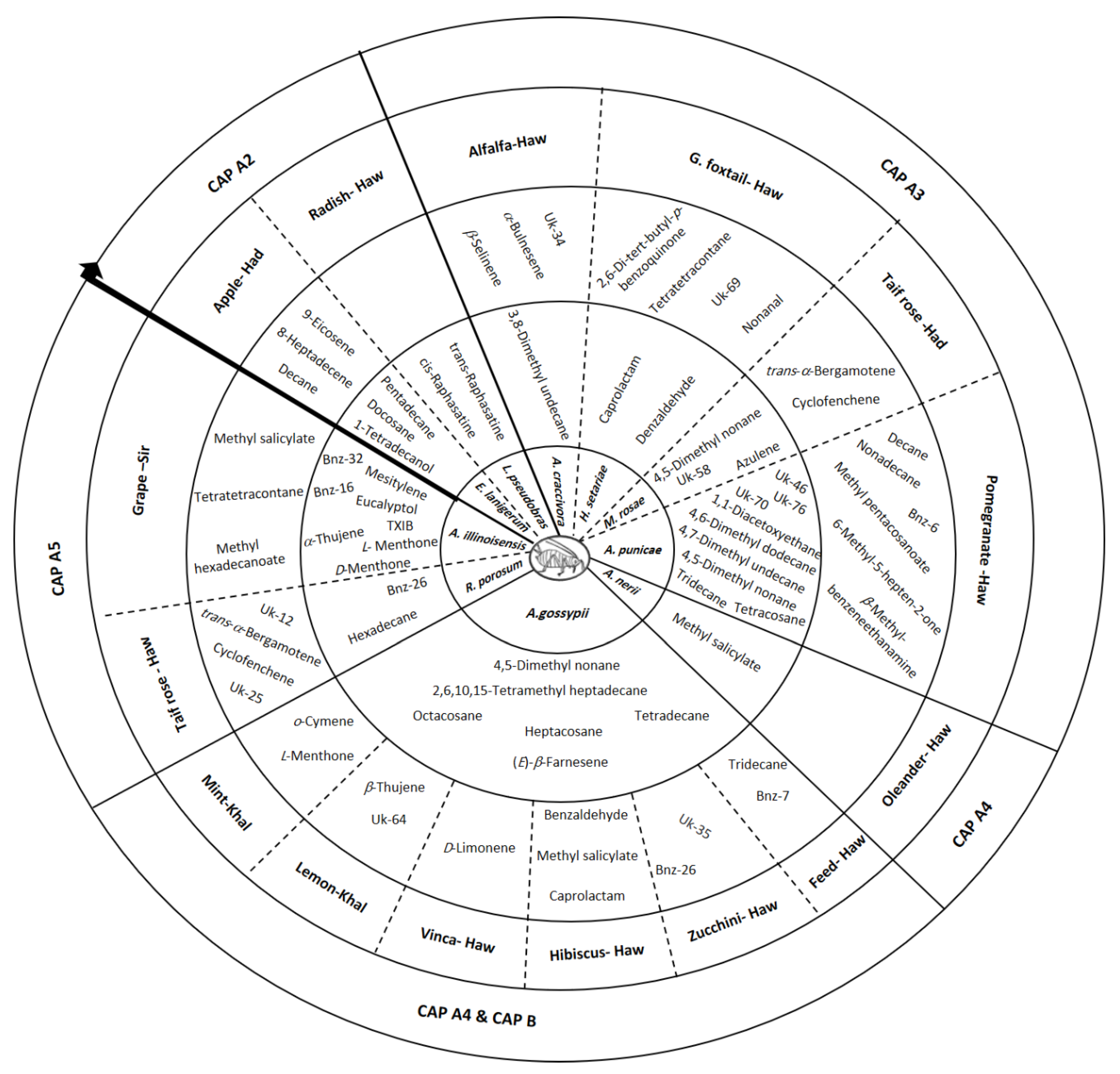
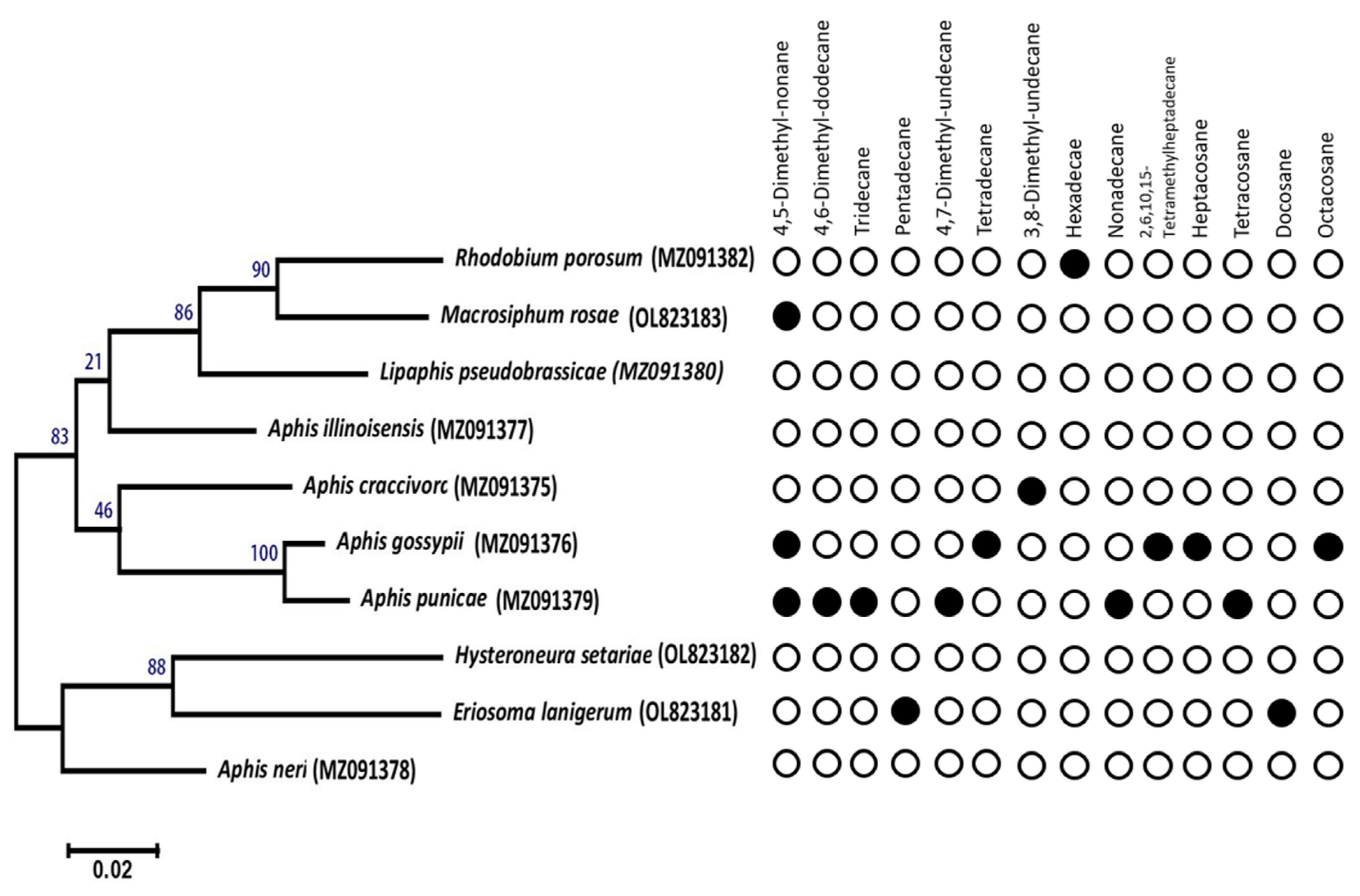
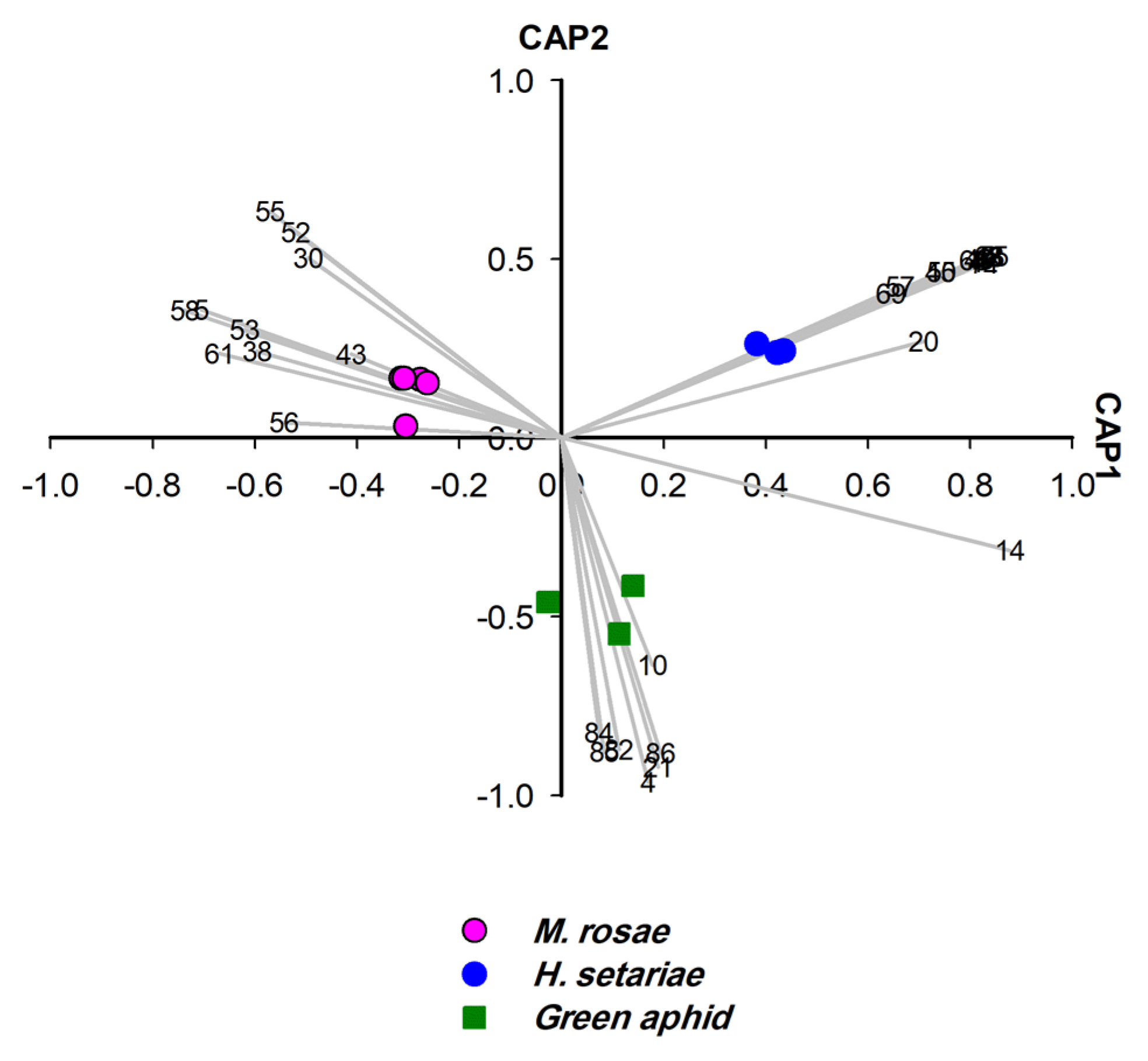
| Questions | Answers |
|---|---|
| Aphid species? | three farmers: aphid of Taif rose two farmers: unknown five scientists: M. rosae |
| Host plants? | three farmers: Taif rose two farmers: Sultani and Taif rose five scientists: unknown |
| State of plant infestation? | Unknown |
| Biomarkers Pattern | |
|---|---|
| EB | α-Thujene (bio4) Eucalyptol (bio21) 3-Carene (bio82) Ψ-Limonene (bio84) α-Pinene (bio85) γ-Terpinene (bio86) |
| SEB | β-Thujene (bio10) |
Disclaimer/Publisher’s Note: The statements, opinions and data contained in all publications are solely those of the individual author(s) and contributor(s) and not of MDPI and/or the editor(s). MDPI and/or the editor(s) disclaim responsibility for any injury to people or property resulting from any ideas, methods, instructions or products referred to in the content. |
© 2023 by the authors. Licensee MDPI, Basel, Switzerland. This article is an open access article distributed under the terms and conditions of the Creative Commons Attribution (CC BY) license (https://creativecommons.org/licenses/by/4.0/).
Share and Cite
Alotaibi, N.J.; Alsufyani, T.; M’sakni, N.H.; Almalki, M.A.; Alghamdi, E.M.; Spiteller, D. Rapid Identification of Aphid Species by Headspace GC-MS and Discriminant Analysis. Insects 2023, 14, 589. https://doi.org/10.3390/insects14070589
Alotaibi NJ, Alsufyani T, M’sakni NH, Almalki MA, Alghamdi EM, Spiteller D. Rapid Identification of Aphid Species by Headspace GC-MS and Discriminant Analysis. Insects. 2023; 14(7):589. https://doi.org/10.3390/insects14070589
Chicago/Turabian StyleAlotaibi, Noura J., Taghreed Alsufyani, Nour Houda M’sakni, Mona A. Almalki, Eman M. Alghamdi, and Dieter Spiteller. 2023. "Rapid Identification of Aphid Species by Headspace GC-MS and Discriminant Analysis" Insects 14, no. 7: 589. https://doi.org/10.3390/insects14070589
APA StyleAlotaibi, N. J., Alsufyani, T., M’sakni, N. H., Almalki, M. A., Alghamdi, E. M., & Spiteller, D. (2023). Rapid Identification of Aphid Species by Headspace GC-MS and Discriminant Analysis. Insects, 14(7), 589. https://doi.org/10.3390/insects14070589






